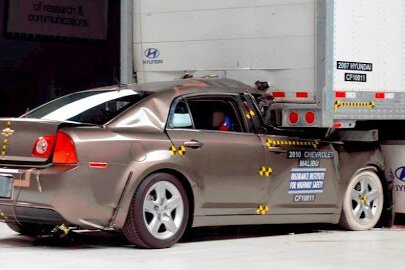An underride crash occurs when a passenger vehicle slides under the body of a tractor-trailer or single-unit truck. Because of the height difference between the vehicles, a passenger vehicle’s safety features, like airbag deployment sensors and crumple zone, are bypassed because the point of impact is above the front bumper. As a result, passenger compartment intrusion can occur, which may result in death or severe head and neck injuries for the occupants.
Tractor-trailers and single unit trucks can be equipped with guards on the rear and sides that prevent underride. Side and front guards are not required in the United States, despite being mandated in numerous other countries.
UPDATE! The multi-year infrastructure bill that was signed into law on November 15, 2021 upgraded the standard for rear underride guards to meet the IIHS TOUGHGUARD award (see below for more information).
Underride Crashes are the result of decades of inaction to fix a well-known design flaw
Rear Underride Guards
Rear Underride Crashes Kill and injure hundreds of people each year in the U.S.
This is an example of a rear underride crash that occurred when a sedan traveling 35 mph collided with the rear of a stationary tractor trailer that meets the current Federal safety standard*. These types of crashes can be prevented by improving the rear-guard standard to meet the IIHS’s TOUGHGUARD award criteria.
*Public Law No: 117-58 was enacted on November 15, 2021. This included language to improve the standard for rear underride guards to meet the IIHS TOUGHGUARD Award standards.
Since 2017, the Insurance Institute for Highway Safety has been testing rear underride guards to a higher standard than required by the federal government and bestowing the TOUGHGUARD award to those who pass. To do so, the rear underride guard must prevent “underride in three crash test scenarios — full-width, 50 percent overlap, and 30 percent overlap — using a midsize car traveling at 35 mph into the back of a semitrailer.” So far, nine trailer manufacturers (including the eight largest manufacturers in the U.S.) produce guards that meet the test’s criteria. See below for a table of the companies that have received the IIHS TOUGHGUARD award:
Great Dane: Applies to all dry van, refrigerated and platform units built after December 2018, in addition to earlier units equipped with the RIG30 option.
Hyundai Translead: Applies to all dry van and refrigerated units built after December 2017 and earlier units equipped with the RIG30 option.
Kentucky Trailer: Applies to all dry vans units with the KT30-RIG option built after February 2020.
Manac: Applies to all 90,000 series dry van, refrigerated and open top units built after June 2011.
Stoughton: Applies to all dry van units built after October 2016.
Strick: Applies to all long dry van models built after December 2018 and short, single-axle vans built after March 2019.
Utility: Applies to all dry van, refrigerated and flatbed units built after December 2019. Also applies to dry van and refrigerated units built before January 2020 and equipped with the additional auxiliary vertical bumper option.
Vanguard: Applies to all dry van units built after December 2015 and all refrigerated units built after September 2016.
Wabash: Applies to dry van units with the RIG-16 option built after February 2016. Applies to refrigerated units with the RIG-16 option built after December 2016.
Side Underride Guards
Side Underride Crashes Result in Serious INjuries and Fatalities.
This is an example of a sedan traveling at 35 mph colliding with the side of a tractor-trailer with an aerodynamic skirt, which is not a side underride guard. Lateral protection devices, which are required in many other countries, protect bicyclists and pedestrians but are not required in the U.S. There are currently side underride guards that exist, which can prevent passenger vehicles from traveling underneath at speeds of up to 35 mph. Side guards and lateral protection devices are not required on tractor-trailers and single unit trucks in the U.S.
The Insurance Institute for Highway Safety (IIHS) has tested a side underride guard. IIHS ran two 35-mph crash tests: one with an AngelWing side underride protection device from Airflow Deflector Inc. and a second test with a fiberglass side skirt intended to improve aerodynamics, not to prevent underride. In both tests, a midsize car struck the center of a 53-foot-long dry van trailer:
In the AngelWing test, the underride guard bent but didn't allow the car to go underneath the trailer, so the car's airbags and safety belt could properly restrain the test dummy in the driver seat.
In the second test with no underride guard for protection, the car ran into the trailer and kept going. The impact sheared off part of the roof, and the sedan became wedged beneath the trailer. In a real-world crash like this, any occupants in the car would likely sustain fatal injuries.



